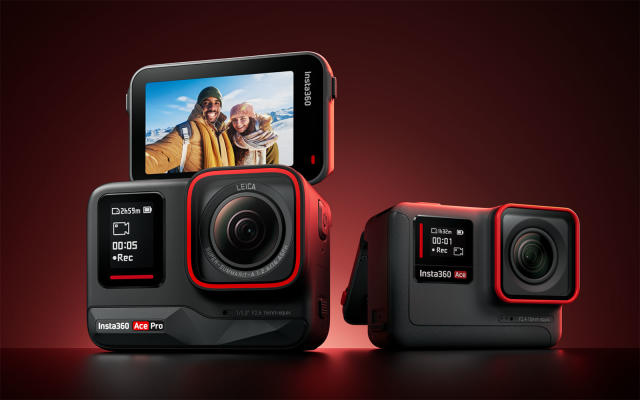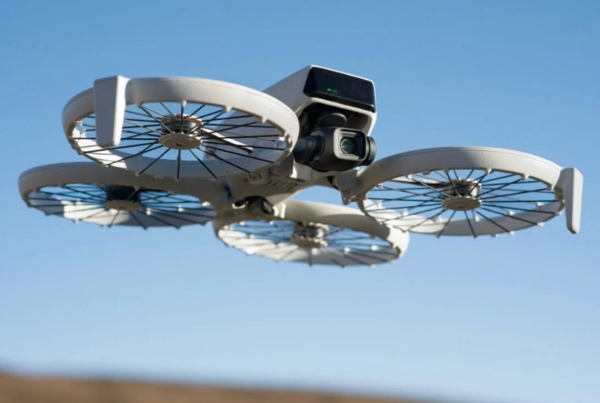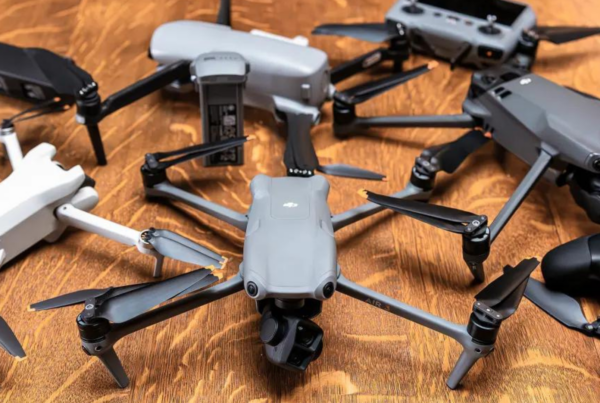
The Ace Pro is the first wide-angle action camera from Insta360, and the company did a great job with it. But Insta360 isn’t new to the camera business; they already have a number of 360-degree cameras and mobile gimbals for sale.
The Ace Pro is in the same price range as the GoPro Hero Black and the DJI Action 4, but it costs more than both of them. I think this is because it has better specs.
Leica has been working with Insta360 for a long time, and they made the 1/1.3-inch sensor for the Ace Pro. This relationship seems to be working out well. The sensor, which is supported by the camera’s AI-enhanced chip, takes great photos and videos, even in difficult lighting conditions like low light and bright sunlight.
You can get up to 8K video and 48MP photos with the Ace Pro. These are both bigger than most people will need. The quality of the output is usually very good, and the HDR Photo mode does a great job of catching detail in the highlights.
This camera is great for all kinds of artistic people because it comes with a magnetic mounting system and a lot of different mounts. The multi mount is very useful because it lets you put the camera on a tripod or carry it around on a selfie stick. Insta360 also makes mounts that work with all kinds of action sports, like surfing, racing, and diving.
I loved everything about the camera, from how well it was put together to how well the movie and photos turned out. That’s a great camera from Insta360. It’s hard to see how they could make it better in the future.
That this camera costs more than the Hero 12 Black and the Action 4 is because of a number of features that make it stand out. The first is the ability to record in 8K. While I was trying, the 8K hardware wasn’t supported by the firmware, so I couldn’t see the results. However, the fact that this feature will be available is impressive, and we can’t wait to test the 8K video mode for our full and thorough review.
One more thing that stands out is the 1/1.3-inch camera. It’s the same size as the Action 4 sensor and bigger than the Hero 12 Black sensor, but not as big as the Osmo Pocket 3 sensor.
The biggest flip screen on the market is 2.4 inches. The Action 4 has a 2.25-inch screen and the Hero 12 Black has a 2.27-inch screen.
I can’t believe how far Insta360 has gone in pushing the limits of what can fit into a small action camera.
Design and Build
- Easy magnetic mount
- Multi mount
- 2.4-inch flip screen
The Ace Pro is very well made and made from good materials. It’s heavier and bigger than other cameras on the market, like the Hero 12 Black, as soon as you take it out of the box. It weighs 179.8g, while the Hero 12 Black weighs 154g and the Action 4 weighs 145g.
This is better because it makes it feel more solid in your hand while still feeling like a sports camera. It also helps heat escape much better, which is the main problem action camera makers have to deal with. If you want a smaller Insta360 camera, the company does make smaller ones for regular people.
The Ace Pro is different from other action cameras in a good way when it comes to how its screens are set up. I sometimes have trouble with DJI and GoPro screens responding, and their front screens never do what I need them to do when I’m taking in selfie mode. The Ace Pro, on the other hand, has a great 2.4-inch flip screen on the back that opens from the top. The hinge is perfectly designed so that the screen can sit safely at any angle. The screen is big and responsive. I really like it.
There are many choices for mounting that you can choose from. There is a sticky plate on the bottom of the camera that lets it be quickly snapped onto different mounts. It follows the Action 4 in this way and leaves the Hero 12 Black behind. Hopefully, the Hero 12 Black will add this feature the next time around. The Insta360 Ace Pro’s sticky mount makes it easy to use it in a variety of situations and get it up and running quickly.
The standard mount works great for riding because it lets you attach the camera to either the helmet or the handlebars. It’s not heavy, and there’s a quarter-inch screw hole in it. There’s also a quick-release mount that hooks onto the camera and can be taken off with the quick-release buttons. I had trouble getting the camera to connect to the prongs the first time. Sometimes I had to fiddle around a bit to make sure that both prongs were locked in, which isn’t ideal.
The multi mount, on the other hand, is a brilliant idea that can be used in a huge range of shooting situations. Like a selfie stick, it can be used as a tripod, or you can just carry it around with you when you need to take pictures while you’re out and about.
Insta360 also added a really nice front display. It’s not a tablet, but it shows you some of the most important settings. It’s a nice feature, but I couldn’t think of a way to use it. If I was taking a picture in face mode, the settings were already showing up on the back of the screen.
Personally, I found it too hard to press the record button. This meant that I couldn’t start recording or taking a picture without moving my hand and adding a wobble to the beginning of the video. This could be easily fixed with a button that responds better.
The camera has all the ports you’d expect, like a microSD slot, a USB-C port, and a place for the battery. All of these are hidden behind flaps that were hard for me to open and close. The power port/microSD port flap only opens wide enough to let the power cable in. The microSD port is also right next to the power cable, which makes it hard to take the card out or put it in while the device is charging.
Features and Performance
- Excellent FlowState stabilization and Horizon Lock
- Waterproof up to 33ft / 10m
- Voice and gesture controls
The Insta360 Ace Pro has a great camera because it was co-designed with Leica. It’s the same sensor that’s in the Osmo Action 4. The sensor is the same size as the Action 4’s (1/1.3 inch) but bigger than the Hero 12 Black’s. It’s not as good as the new 1-inch sensor in the DJI Osmo Pocket 3, though. Since this camera has a bigger body, I wonder if this bigger sensor will be added to a future Ace Pro camera.
The 1/1.3-inch sensor and f/2.6 lens make it possible for great low-light performance, but we’ll talk more about that later. The 5nm AI chip can get rid of a lot of noise, which is great for scenes that happen at night and you can’t get rid of all the noise in the camera. The chip’s AI also makes it better at handling the opposite situation, where there are bright light sources in the shot. This is something that is hard for any camera to do, let alone a small action camera.
The camera’s stabilization is based on FlowState and Horizon Lock, which are traits that almost all other action cameras do well. Insta360’s own formula, FlowState, has been tested and found to work well on its other cameras. Horizon Lock does just that, and it works best when the camera is turned around a lot during the shot.
The video resolution goes up to 8K, but when I tested it, the firmware would only let me test up to 4K. As we already said, we’ll do a full review after trying the 8K mode in detail. The Hero 12 Black has a resolution of up to 5.3K and the Action 4 has a resolution of up to 4K. Not many people will need 8K in this kind of camera or have a screen big enough to see it, but the Insta360 Ace Pro has it if it’s important to your work.
A cool but not unique feature on the camera is called “Photo Grab,” and it lets you take 12MP pictures while you’re watching video. We’ll talk about how good the video and photos are from this camera another time.
The camera is waterproof up to 10 meters, which is deep enough for most situations. However, if you need to shoot at a deeper depth, you can buy a different dive case that lets you use the camera up to 16 meters deep.
The motion control is one thing I really like. When you raise your hand, the camera will start taking video. There will be a three-second countdown to give you time to get ready. It will take a picture of you after three seconds if you make the “peace” sign. These kinds of tools are great because they make using the camera less necessary.
Image and Video Quality
- Max photo resolution: 48MP (8064 x 6048)
- Video: 8K 24fps / 4K 120fps / 1080 240fps
- Active HDR
The results that the Insta360 Ace Pro gives are truly impressive. How do we begin? How about performance in low light? Over the years, this is where a lot of action cams have gone wrong. Everything is fine if the lighting is just right, but artists don’t want their technology to hold them back.
The Ace Pro works well in low light, and during testing, only a small amount of noise was visible. The AI-enhanced chip helps get rid of more of the noise that the 1/1.3-inch camera can’t. Both video and photos work well in low light thanks to this.

There are, however, much better ways to get those details with the HDR shot mode. When I took a picture of a cloudy sky, for example, the clouds were clear, but when I recorded video, the sky was completely white.
The color reproduction is very good in all modes, and very little to no correction is needed to make the colors look like they do in real life. I was glad to see that the Insta360 Ace Pro did such a good job with this because GoPro and DJI cameras often have trouble with it. This color replication can also be seen in the skin tones and faces, which are also captured correctly.
The GoPro Hero 12 Black doesn’t have log capture like the GP-Log, which is a shame. This makes it harder to change the colors after the fact, and adding that function would really take this camera to the next level.
Buy it if
You want an 8K action camera
Not many users will need 8K in this type of camera, or have the display to watch it on, but if that’s important to your workflow then the Insta360 Ace Pro delivers.
You love a flip screen
The 2.4-inch rear flip-screen is wonderfully engineered, and enables the user to see their video feed in high definition whether they’re behind or in front of the camera.
You want to post your videos to Instagram, TikTok, and YouTube
With its portrait filming functionality, the Insta360 Ace Pro is ideal for shooting videos that can be uploaded to your favorite social media app.
Don’t Buy it if
You want a front and rear screen
If you want a traditional implementation of a front and rear screen then you’ll need a GoPro or DJI. The Insta360 Ace Pro has a flip-screen alternative.
You want the lightest action camera
The Insta360 Ace Pro weighs 179.8g, compared to 154g for the Hero 12 Black and 145g for the Action 4.
You want log capture functionality
If color grading is important to you then you won’t find any log capturing functionality in this camera. You’ll need to buy the GoPro Hero 12 Black instead.









